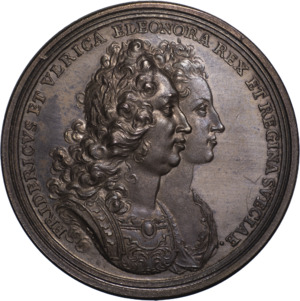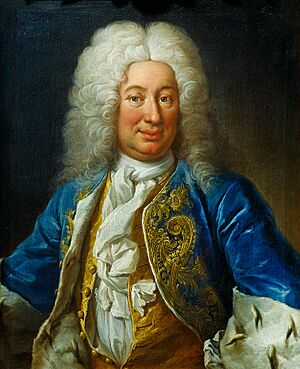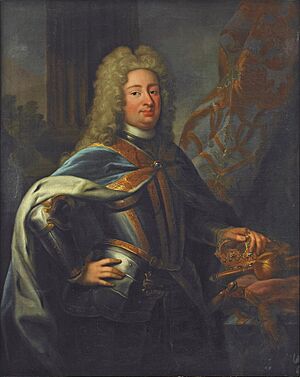Frederick I of Sweden facts for kids
Quick facts for kids Frederick I |
|
|---|---|
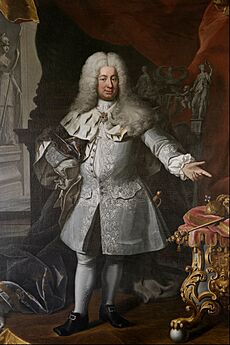
Portrait by Georg Engelhard Schröder, c. 1730s
|
|
| King of Sweden | |
| Reign | 24 March 1720 – 5 April 1751 |
| Coronation | 3 May 1720 |
| Predecessor | Ulrika Eleonora |
| Successor | Adolf Frederick |
| Landgrave of Hesse-Kassel | |
| Reign | 23 March 1730 – 5 April 1751 |
| Predecessor | Charles I |
| Successor | William VIII |
| Prince consort of Sweden | |
| Tenure | 5 December 1718 – 29 February 1720 |
| Born | 28 April 1676 Kassel, Hesse-Kassel |
| Died | 5 April 1751 (aged 74) Stockholm, Sweden |
| Burial | 27 September 1751 Riddarholmen Church |
| Spouse |
Luise Dorothea of Prussia
(m. 1700; died 1705) |
| Issue more... |
Frederick William von Hessenstein |
| House | Hesse-Kassel |
| Father | Charles I, Landgrave of Hesse-Kassel |
| Mother | Maria Amalia of Courland |
| Religion | Protestant |
| Signature | |
Frederick I (Swedish: Fredrik I; 28 April 1676 – 5 April 1751) was the King of Sweden from 1720 until his death. Before that, he was the prince consort of Sweden from 1718 to 1720. He was also the Landgrave of Hesse-Kassel starting in 1730.
Frederick became king after his brother-in-law, Charles XII, died during the Great Northern War. His wife, Ulrika Eleonora, who was Charles's sister, gave up her throne. She did this because she had to give up most of her power to the Riksdag of the Estates (the Swedish parliament). Frederick's time as king was not very powerful. He also had no children who could legally inherit the throne.
Contents
Early Life and Military Career
Frederick was born on April 28, 1676, in Kassel, Hesse-Kassel. His father was Charles I, Landgrave of Hesse-Kassel, and his mother was Princess Maria Amalia of Courland.
As a young prince, Frederick traveled a lot. In 1692, he visited the Dutch Republic. In 1695, he went to the Italian Peninsula. He also studied in Geneva.
After his studies, Frederick joined the military. He led Hessian troops as a Lieutenant General. He fought in the War of the Spanish Succession. In 1703, he lost a battle at Battle of Speyerbach. But the next year, he was part of a big victory at the Battle of Blenheim. In 1706, he was defeated again by the French. He also joined Charles XII of Sweden in his campaigns against Norway in 1716 and 1718. He was made a Swedish General.
Prince Consort of Sweden
In 1715, Frederick married his second wife, Princess Ulrika Eleonora of Sweden. When Ulrika Eleonora became queen in 1718, Frederick was given the title Prince of Sweden. He was known as Royal Highness.
He became the prince consort of Sweden. This means he was the husband of the ruling queen. He is the only prince consort Sweden has had so far. Frederick had a lot of influence during his wife's rule.
After Charles XII died in 1718, Ulrika Eleonora became queen. But she had to share power with the parliament. Because of this, she decided to give up her throne in 1720. She chose Frederick to be the next king.
King of Sweden
Frederick became King of Sweden in 1720. The Swedish parliament chose him.
The wars under Charles XII, especially the Great Northern War, had weakened Sweden. Under Frederick, Sweden had to accept that it was no longer a major European power. In 1721, Sweden gave up Estonia, Ingria, and Livonia to Russia in the Treaty of Nystad.
At the start of his 31-year reign, Frederick was very active. But after the Swedish nobles gained more power, he became less interested in governing. In 1723, he tried to get more power for himself, but he failed. After that, he did not get involved much in politics. He even used a stamp of his signature instead of signing official papers himself.
Frederick spent most of his time hunting and on his personal life. He and Queen Ulrika Eleonora did not have any children together. However, he had several children with his partner, Hedvig Taube.
In 1723, Frederick rewarded Sven Åderman, a military inventor. Åderman had improved the speed of firing a musket. Frederick gave him the Halltorps estate on the island of Öland.
Frederick was not very respected as a king. People said that many good things happened in Sweden during his reign, but he had nothing to do with them. For example, the Stockholm Palace was built, but he was never curious enough to look at it. One of his few important decisions was to ban duels.
On February 23, 1748, Frederick I created three important Swedish royal orders: the Order of the Seraphim, the Order of the Sword, and the Order of the North Star. These are special awards given for bravery or service.
Landgrave of Hesse-Kassel
Frederick became the Landgrave of Hesse in 1730. This was ten years after he became King of Sweden. A Landgrave was a ruler of a German territory. He immediately made his younger brother, William, the governor of Hesse.
As Landgrave, Frederick was not seen as very successful. He focused more on Sweden. Because he had less power and income as King of Sweden, he used money from wealthy Hesse to pay for his court in Sweden. This meant he acted like an absentee landlord. He took resources from Hesse to fund his life in Sweden.
Frederick's father, Charles I, Landgrave of Hesse-Kassel, had been a very successful ruler. He rebuilt Hesse-Kassel by improving the economy and infrastructure. He also welcomed French Huguenots, which helped the economy. Frederick's brother, William VIII, who became Landgrave after him, was also a successful ruler in Hesse.
There are not many things left in Hesse today that remind people of Frederick. One example is his large royal Swedish signature (FR) above the old door of the University of Marburg's former riding hall.
Family and Issue
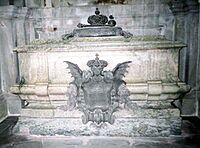
On May 31, 1700, Frederick married his first wife, Luise Dorothea (1680–1705). She was a princess from Prussia. Luise Dorothea died in December 1705 during childbirth.
His second wife was Ulrika Eleonora (1688–1741), a princess of Sweden. They married in 1715. Ulrika had two miscarriages, one in 1715 and another in 1718. They did not have any children who survived.
Frederick I had three children with his partner, Hedvig Taube, who were born outside of his marriage:
- Frederick William von Hessenstein (1735–1808)
- Charles Edward von Hessenstein (1737–1769)
- Hedwig Amalia von Hessenstein (1743–1752)
After Hedvig Taube passed away, his official partner was Catharina Ebba Horn (1720–1781). He gave her the title of Countess in 1745.
Because Frederick had no legal children to inherit the Swedish throne, the House of Holstein-Gottorp took over after him. In Hesse-Kassel, his younger brother William VIII became the next Landgrave.
Images for kids
See also
 In Spanish: Federico I de Suecia para niños
In Spanish: Federico I de Suecia para niños


